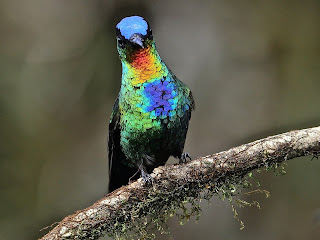Bridging the Gap: Peace Development Between the Leprosy-Affected Community and Surrounding Community in Addis Ababa
Bridging the Gap: Peace Development Between the Leprosy-Affected Community and Surrounding Community in Addis Ababa
 |
|
Fisseha with community representatives from the leprosy-affected
community and non-leprosy-affected surrounding community
|
The concept of the project came about from my work with those with leprosy in affected communities. In many countries, people affected by leprosy face a number of social and economic problems, such as discrimination and stigma. These issues are even worse for individuals who experience disability due to leprosy. They are more vulnerable to the endless stigma and discrimination than any other form of disability in our society.
Even after someone with leprosy has been cured, they’re unable to lead an ordinary life due to the consequences of lingering complications. Some of the most difficult complications experienced are they forced to live as a colony in specific area and they did not get access for education. As a result of the wide misconceptions that exist about leprosy, many of those affected are forced to leave their birth places and live in segregated groups, known as leprosy colonies. In the capital of Ethiopia, Addis Ababa, individuals who have been affected by leprosy are deliberately pushed out of the city and made to settle in a solid waste dumping site with no infrastructure and poor social services.
The leprosy-affected community of Addis Ababa is called the “Zenebework Community.” The majority of early settlers in the area were leprosy victims who largely migrated here from various other parts of the country– mainly Amhara, Tigray, Oromia, and SNNP regions. Their goal was to receive medical treatment for their leprosy at ALERT (All African Leprosy Rehabilitation and Training Centre) Hospital, formerly known as Zenebework Hospital.
After treatment, the leprosy victims were supposed to go back to their place of origin, as direct by the government, but the majority of them refused, preferring to remain in this area where they’d received treatment. This resulting settlement was named after the Zenebework Hospital, which had been established in 1932 and named after Princess Zenebework, daughter to Emperor Haileselassie. In 1949, the Abune Aregawi/Gebre Kristos Church was established in the same area, resulting in this name also being used for the locality. When construction began on the hospital in its present form as ALERT in 1967 and was later inaugurated in 1971, many other institutions, such as schools, followed. This provided a basic infrastructure that the leprosy victims had previously been completely without.

Below is an outline of the expected outcomes and major activities set in place to bring about this objective:
Expected Outcomes
Major Activities
 Fisseha is an Ethiopian who has more than 15 years of proven and practical work experience in different organizations. He’s worked in agricultural research institutes and both international and local NGOs, while holding different positions such as Research Technical Assistant, Development Facilitator, Project Officer, Program Coordinator, and Executive Director. He currently runs an NGO called Child of Present a Man of Tomorrow (CPMT) in Ethiopia, which works to promote the wellbeing of women and children. He is also presently studying a Master’s degree in Applied Community Change in Conservation concentration at Future Generations University to complement his backgrounds in agriculture, development and leadership.
Fisseha is an Ethiopian who has more than 15 years of proven and practical work experience in different organizations. He’s worked in agricultural research institutes and both international and local NGOs, while holding different positions such as Research Technical Assistant, Development Facilitator, Project Officer, Program Coordinator, and Executive Director. He currently runs an NGO called Child of Present a Man of Tomorrow (CPMT) in Ethiopia, which works to promote the wellbeing of women and children. He is also presently studying a Master’s degree in Applied Community Change in Conservation concentration at Future Generations University to complement his backgrounds in agriculture, development and leadership.Musings of a Naturalist III: QUETZALS AND COSTA RICA
Musings of a Naturalist III: QUETZALS AND COSTA RICA
Jorge, a member of the extensive Serrano family, grew up in quetzal country and while studying rural tourism at his local high school, realized that showing quetzals to visitors could be a key income generating opportunity for the family – if only they could work out a system.
‘Quetzal tours’ were already in vogue in other quetzal hot spots such as Savegre Valley and Monteverde. Eager to see one of these birds, we visited the Savegre Valley where we engaged Marino Chacon as our driver/guide. Early one February morning he drove us slowly up the main road from the Savegre Lodge until he heard a bird and then quickly spotted a fine male sitting on a moss-covered branch in the cloud forest. There, in front of us, was an experience we will long remember: the classical image of a stunning quetzal.
In 2009 Jorge started his scheme by coaxing local farmers to search their property each morning, looking for quetzals, and should they find a bird, report to the lodge on their cell phones. Quetzals feed on wild fruit – especially wild avocados – as well as on frogs and lizards (during the rainy season) and once breakfast is ingested they usually sit quietly on a branch for extended periods. Thus guests at the lodge who are interested – and have paid a substantial fee – climb aboard a vehicle for a ride of fifteen or so minutes to the selected farm. Once you know where a bird is resting, the chances of arriving guests seeing a quetzal is high. Another seasonal method of locating quetzals, and one popular along main roads, is to find a nest with chicks and then watch the adult birds coming and going. The nesting season on the Pacific side of the Cerro del Muerte uplift normally begins early in March and lasts into May.
 |
|
The lodge’s mission statement speaks to the importance
of taking pride in caring for Mother Nature for future generations.
|
Jorge’s program, started with only two farmers, but now has become so successful that his list of reporting individuals has grown to twenty-two with two more waiting in the wings. In the high season, the lodge runs three ‘quetzal tours’ a day, each with a limit of ~6 people per group. It is mportant to limit the number of visitors to any one site, Jorge says, so as not to overly disturb the birds. Evidence of the success of this program is that some farmers are now planting wild avocados and other fruit-bearing trees on their properties.
_________________________________________________________
|
Dr. Fleming with naturalist/guide Alanzo (pictured right), Quetzal showing
farmer William (left) and Serrano family member (far left); photo
taken by James Regali, Bob’s companion on the Quetzal search.
|
This week’s blog piece and photos make up the third installment in our Musings of a Naturalist series, courtesy of our own Dr. Robert (Bob) Fleming: Professor Equity and Empowerment/ Natural History. Having grown up in the foothills of the Himalayas in India, Bob has long been interested in the beauty of nature. This progressed into a fascination with natural history and cultural diversity, leading him to obtain his Ph.D. in zoology. He has explored many of the planet’s special biological regions, ranging from the Namib Desert in Africa to the Tropical Rainforest of the Amazon, and the Mountain Tundra biome of the Himalayas. He has worked for the Smithsonian’s Office of Ecology and the Royal Nepal Academy and, along with his father and Royal Nepal Academy Director-Lain Singh Bangdel, he wrote and illustrated “Birds of Nepal,” the first modern field guide to the birds of the region. In addition to his work with Future Generations, Bob is the director of Nature Himalayas, a sole proprietorship that he began in 1970. Through this company, Bob has led some 250 outings. He currently lives in the temperate rainforest of western Oregon in the USA’s Pacific Northwest.
Many thanks to Dr. Fleming for another great contribution!
Happy Father’s Day from Future Generations!
Happy Father’s Day from Future Generations!
Luke Taylor-Ide has worked to combine academic interest in applied education with a parallel field-oriented approach to social change, having had extended, multi-year assignments in Afghanistan, India, and rural America. His findings affected national health policy in Afghanistan in regards to enabling women, and addressed the impacts of modernization on sustainable living in India. He currently focuses on the intersection of local agriculture economies, community-based preventive healthcare, and entrepreneurship in West Virginia.
Is there a project in particular that you all worked on that really sticks out to you?
Probably the most memorable project that I worked on with my father and grandfather was the “Pregnancy History Project” in Afghanistan and India. Several points are noteworthy about this project, most importantly it was the closest professional collaboration I got to share with my grandfather—it ended up being his last major research and action project. During this time, Bapu (Carl) and I traveled to Afghanistan and India to first launch a research effort to assess the impact of the Pregnancy History Method implemented 2 years earlier in Afghanistan and then also launch a parallel implementation approach in Arunachal Pradesh, India. We were closing our time in Kabul, Afghanistan when Dad (Dan’l) arrived to complete programatic work and we all overlapped for two nights in the guest house of the International Assistance Mission. One night we got into a debate about the appropriate placement and role for the concept of establishing a Shared Vision for change in community within SEED-SCALE. Each of us had a strong opinion and they were all different; we debated that point for hours in the living room until the other guests united and asked us to go to bed—we had no idea how late or opinionated we each had become. I am still not sure that any of us went to bed that night at all convinced of the other’s views—but I expect each of us thought our point had come out on top.
What’s the greatest benefit to working with your father?
We get to spend a lot of time together! As a result of interacting on a virtually daily basis, usually regarding work, we have learned to adapt our relationship from one of typical father-son to being colleagues and friends. We gain insight into one another’s daily life in a way that most father-son relationships cannot do. While this can be a delicate balance, having an enduring relationship that has evolved throughout the years has allowed us to know one another professionally as well as personally, which for better or for worse has brought us closer together.
What’s the hardest thing about working with your father?
At times the line between our professional and personal relationship can get blurred which adds significant strain on both. It is often difficult for us to “turn off” work when we are together. While this can have its perks such as working through a complex issue over dinner, it can also easily turn a relaxing evening into a night of work and debate. Unlike many working relationships, we are unable to cut ties completely if we have a disagreement so we generally work out our different views and are both better for it—but getting to common ground is not always the most fun.
What’s been your most memorable interaction while working with family?
The Ecological Footprint of Afghanistan and More: A Comparison of Afghanistan with Iran and Pakistan
The Ecological Footprint of Afghanistan and More: A Comparison of Afghanistan with Iran and Pakistan
Comparison of Afghanistan, Iran, and Pakistan
Similarities:
 Turkmenistan, Afghanistan, Pakistan, and India, just recently started the TAPI project, which will further establish Afghanistan as a connecting point for Central and Southeast Asia. Through this project, natural gas will be sent from Turkmenistan to Pakistan, via Afghanistan, and then via Pakistan to India. The similarities, from an economic standpoint, can be seen as significant. The contribution from all of these countries, and in general, Central Asia with Southeast Asia, makes a great impact on the planet’s finite resources. This is especially so in the case of Central Asia’s supply of natural gas, and the high demand for it in Southeast Asia.
Turkmenistan, Afghanistan, Pakistan, and India, just recently started the TAPI project, which will further establish Afghanistan as a connecting point for Central and Southeast Asia. Through this project, natural gas will be sent from Turkmenistan to Pakistan, via Afghanistan, and then via Pakistan to India. The similarities, from an economic standpoint, can be seen as significant. The contribution from all of these countries, and in general, Central Asia with Southeast Asia, makes a great impact on the planet’s finite resources. This is especially so in the case of Central Asia’s supply of natural gas, and the high demand for it in Southeast Asia.
Differences:
The Main Factors Subject to Difference:
-
Huge population of Pakistan, and the ongoing fear of poverty in this country
-
The economic crises in Iran
-
The ongoing insurgency and terrorism threats in Afghanistan
-
The ongoing fear and increase in the percentage of poverty in Afghanistan
Conclusion of Differences, Potential Directions to be Taken
Personal Footprint
 |
| Afghanistan |
_____________________________________________________
 This week’s blog post contributed by Future Generations Alumnus Yasar Ahmadzai. Yasar has more than a decade’s worth of experience in the fields of peacebuilding, community development, democratization, and journalism. Carrying international expertise into the field of positive community change, Yasar was recently featured for his peacebuilding efforts by the Global Peacebuilding Center and the United States Institute of Peace. He previously worked with the Afghanistan High Peace Council, and also has the practical experience of working with different government institutions in Afghanistan and in the ongoing peace negotiations taking place in the country.
This week’s blog post contributed by Future Generations Alumnus Yasar Ahmadzai. Yasar has more than a decade’s worth of experience in the fields of peacebuilding, community development, democratization, and journalism. Carrying international expertise into the field of positive community change, Yasar was recently featured for his peacebuilding efforts by the Global Peacebuilding Center and the United States Institute of Peace. He previously worked with the Afghanistan High Peace Council, and also has the practical experience of working with different government institutions in Afghanistan and in the ongoing peace negotiations taking place in the country.
Empowering the Forgotten Peacebuilders: Persons with Disability
Empowering the Forgotten Peacebuilders: Persons with Disability
Using Self-Help Groups and Information Technology to Empower People with Disability in Tanzania: A lesson from the Nyamagana and Ilemela Districts of Mwanza City
|
Tusaidiane Disabilities Resources and Charity Organization of Tanzania, the NGO
started by Msafiri to address many of the issues noted in this study
|
 |
|
Disability consortium in the author’s community in the Lake Victoria
area of Mwanza
|
____________________________________________________________________












